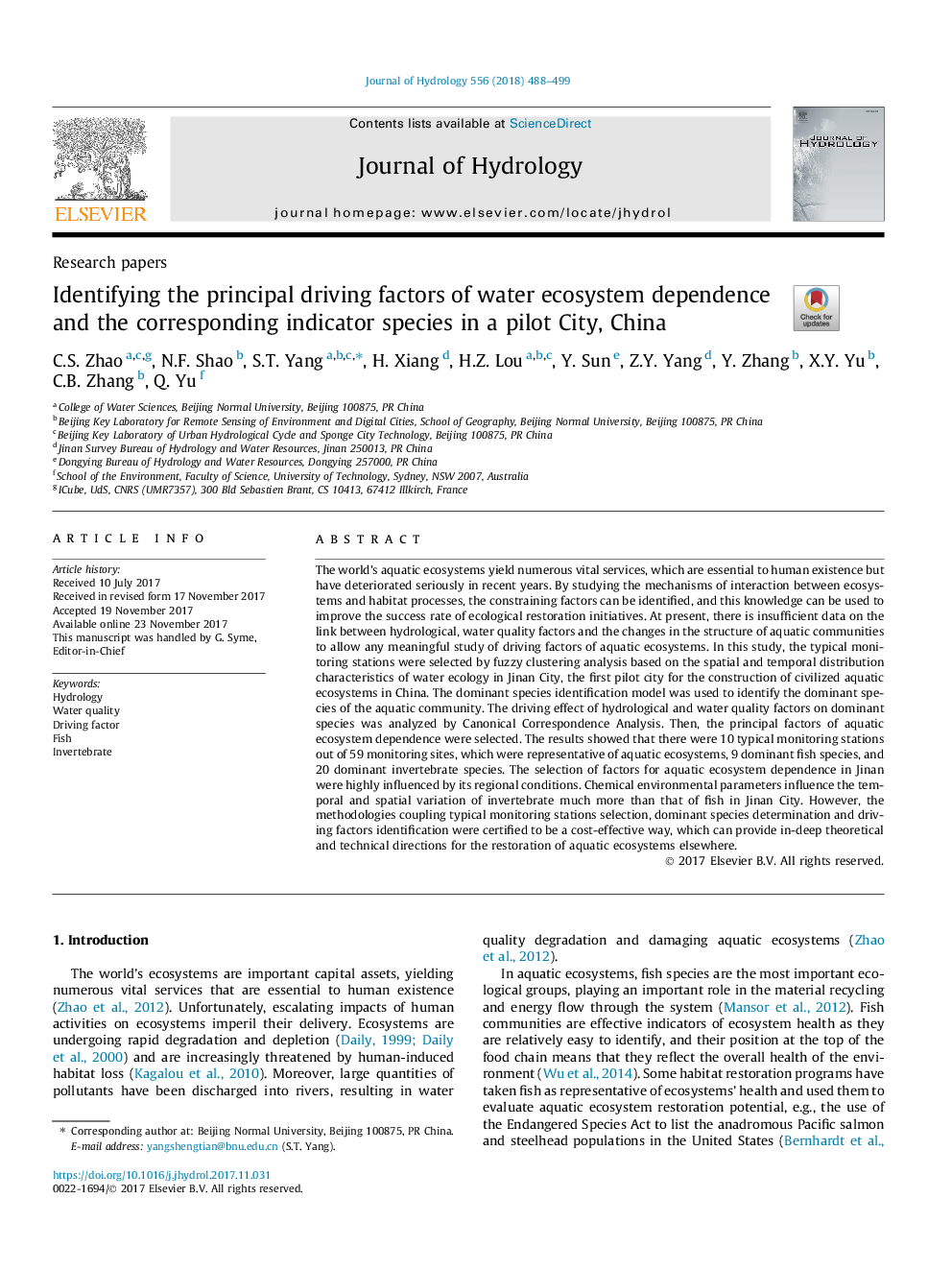| کد مقاله | کد نشریه | سال انتشار | مقاله انگلیسی | نسخه تمام متن |
|---|---|---|---|---|
| 8895148 | 1629898 | 2018 | 12 صفحه PDF | دانلود رایگان |
عنوان انگلیسی مقاله ISI
Identifying the principal driving factors of water ecosystem dependence and the corresponding indicator species in a pilot City, China
ترجمه فارسی عنوان
شناسایی عوامل موثر اصلی وابستگی اکوسیستم آب و گونه های شاخص مربوطه در یک شهر خلبان،
دانلود مقاله + سفارش ترجمه
دانلود مقاله ISI انگلیسی
رایگان برای ایرانیان
کلمات کلیدی
هیدرولوژی، کیفیت آب، عامل رانندگی ماهی، بی مهره،
ترجمه چکیده
اکوسیستم های آبزی در جهان، خدمات حیاتی متعددی را ارائه می دهند که برای زندگی انسان ضروری است اما در سال های اخیر به طور جدی رو به وخامت گذاشته است. با بررسی مکانیسم های تعامل بین اکوسیستم ها و فرآیندهای زیستگاه، عوامل محدود کننده می توانند شناسایی شوند و این دانش می تواند برای بهبود میزان موفقیت طرح های بازسازی محیطی استفاده شود. در حال حاضر، داده های کافی در مورد ارتباط بین عوامل هیدرولوژیکی، کیفیت آب و تغییرات ساختار جوامع آبزی وجود ندارد، به طوری که هر مطالعه معنی دار عوامل رانندگی اکوسیستم های آبزی را امکان پذیر سازد. در این مطالعه، ایستگاه های نظارت معمولی با استفاده از تجزیه و تحلیل خوشه ای فازی بر اساس ویژگی های توزیع فضایی و زمانی از محیط زیست آب در شهر جینان، اولین شهر آزمایشی برای ساخت اکوسیستم های آبزی متمدن در چین، انتخاب شدند. مدل شناسایی گونه های غالب برای شناسایی گونه های غالب جامعه آبزی استفاده شد. اثر راندمان فاکتورهای هیدرولوژیکی و کیفیت آب بر گونه های غالب توسط تجزیه و تحلیل مربوط به کانونیکال تحلیل شد. سپس عوامل اصلی وابستگی اکوسیستم آبزی انتخاب شدند. نتایج نشان داد که 10 ایستگاه نظارت معمول از 59 ایستگاه نظارت، که نشان دهنده اکوسیستم های آبزی، 9 گونه غالب غالب و 20 گونه غیرمعمول غالب بود، وجود داشت. انتخاب عوامل برای وابستگی اکوسیستم آبزی در جینان به شدت تحت تاثیر شرایط منطقه قرار گرفت. پارامترهای زیست محیطی شیمیایی تغییرات زمانی و مکانی بی مهره را بسیار بیشتر از ماهی در شهر جینان تأثیر می گذارد. با این وجود، روش شناسایی پیاده سازی ایستگاه های نظارت معمول، شناسایی گونه های غالب و شناسایی عوامل رانندگی، یک راه مقرون به صرفه بود که می تواند جهت عمیق نظری و فنی برای بازگرداندن اکوسیستم های آبزی در جای دیگر را تأیید کند.
موضوعات مرتبط
مهندسی و علوم پایه
علوم زمین و سیارات
فرآیندهای سطح زمین
چکیده انگلیسی
The world's aquatic ecosystems yield numerous vital services, which are essential to human existence but have deteriorated seriously in recent years. By studying the mechanisms of interaction between ecosystems and habitat processes, the constraining factors can be identified, and this knowledge can be used to improve the success rate of ecological restoration initiatives. At present, there is insufficient data on the link between hydrological, water quality factors and the changes in the structure of aquatic communities to allow any meaningful study of driving factors of aquatic ecosystems. In this study, the typical monitoring stations were selected by fuzzy clustering analysis based on the spatial and temporal distribution characteristics of water ecology in Jinan City, the first pilot city for the construction of civilized aquatic ecosystems in China. The dominant species identification model was used to identify the dominant species of the aquatic community. The driving effect of hydrological and water quality factors on dominant species was analyzed by Canonical Correspondence Analysis. Then, the principal factors of aquatic ecosystem dependence were selected. The results showed that there were 10 typical monitoring stations out of 59 monitoring sites, which were representative of aquatic ecosystems, 9 dominant fish species, and 20 dominant invertebrate species. The selection of factors for aquatic ecosystem dependence in Jinan were highly influenced by its regional conditions. Chemical environmental parameters influence the temporal and spatial variation of invertebrate much more than that of fish in Jinan City. However, the methodologies coupling typical monitoring stations selection, dominant species determination and driving factors identification were certified to be a cost-effective way, which can provide in-deep theoretical and technical directions for the restoration of aquatic ecosystems elsewhere.
ناشر
Database: Elsevier - ScienceDirect (ساینس دایرکت)
Journal: Journal of Hydrology - Volume 556, January 2018, Pages 488-499
Journal: Journal of Hydrology - Volume 556, January 2018, Pages 488-499
نویسندگان
C.S. Zhao, N.F. Shao, S.T. Yang, H. Xiang, H.Z. Lou, Y. Sun, Z.Y. Yang, Y. Zhang, X.Y. Yu, C.B. Zhang, Q. Yu,
